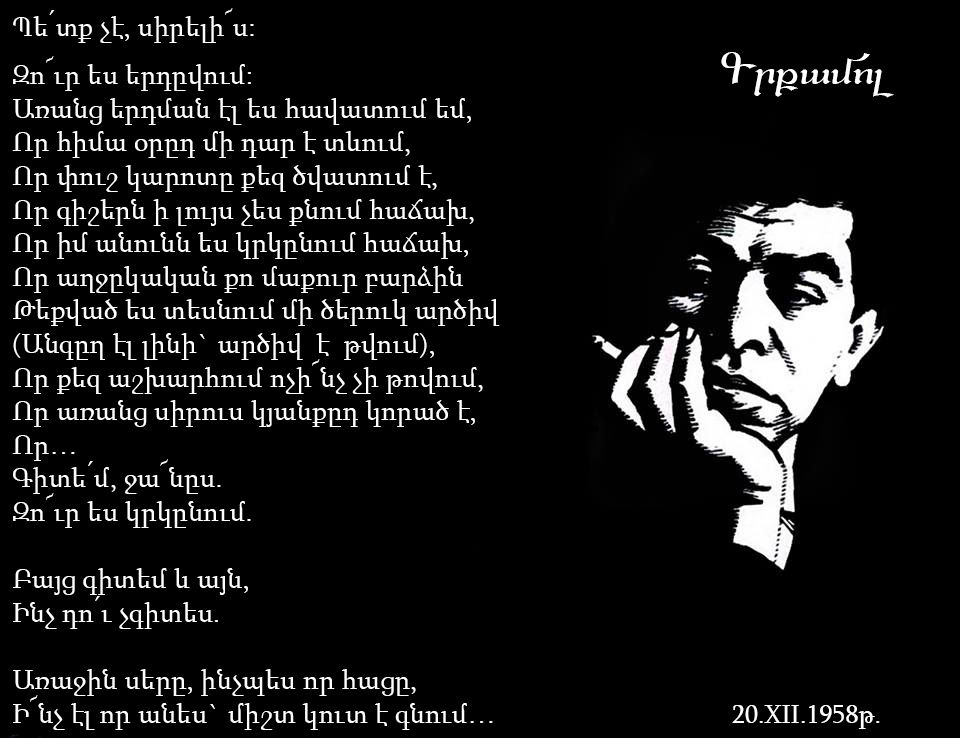Paruyr Sevak Siro Masin

Կայքում տեղ գտած մտքերն ու տեսակետները հեղինակի սեփականությունն են և կարող են չհամընկնել BlogNews.am-ի խմբագրության տեսակետների հետ. KENAC SIRO MASIN. Skip navigation Sign in. This video is unavailable. Paruyr Sevak Erjanik exir davachan im ser - Duration: 5:12.
Contents • • • • • • • Biography [ ] Sevak was born Paruyr Ghazaryan (: Պարույր Ղազարյան) in Chanakhchi (now ) village,, to Rafael Ghazaryan and Anahit Soghomonyan on January 24, 1924. Young Paruyr attended the village school and later in 1940 moved to Yerevan to study at the philological faculty of. He graduated from the YSU in 1945. The same year he starts a postgraduate study of Armenian literature at the Academy of Sciences Abeghyan Institute of Literature. In 1951 Sevak went to Moscow to study at the. Graduating from that institute Paruyr works there in 1957-59 as a translating professor.

Inspired by the Western Armenian poet, Paruyr Ghazaryan adopted the name Paruyr Sevak as his. In 1960 Sevak returns to Yerevan and starts his fecund and meaningful literary, scientific and public activism. He starts to work at the Abeghyan Institute of Literature as a scientific researcher. From 1966-1971 Sevak served as the Secretary of the Board of the. In 1967 Sevak became a doctor of philology after dissertation defense. In 1968 he was elected to the Supreme Council of the.
Paruyr Sevak's Plaque in Yerevan on Kasyan street Sevak died on June 17, 1971 in a car crash while on a drive back to Yerevan. In previous years, he had voiced his criticism of the corruption of the Soviet establishment and for this, many Armenians believe, he was murdered by the Soviet government. His wife, Nelly Menagharishvili, also died in the car crash. He was buried in the backyard of his home, in Zangakatun, which later became a museum open to everyone.
Literary work [ ] Sevak's poem The Unsilenceable Belfry is dedicated to Armenian composer and to the remembrance of the. Publications [ ] • Immortals Command (Անմահները հրամայում են) — 1948 • Uncompromising Intimacy (Անհաշտ մտերմություն) — 1953 • Love Road (Սիրո ճանապարհ) — 1954 • The Unsilenceable Belfry (Անլռելի Զանգակատուն) — 1959 • Man in a Palm (Մարդը ափի մեջ) — 1964 • Sayat Nova (Սայաթ Նովա) — 1969 • Let There Be Light (Եղիցի լույս) — 1969 • Your Acquaintances (Ձեր ծանոթները) — 1971 Legacy and memory [ ] One of the mains streets of Yerevan's district is named after Sevak. School #123 of Yerevan is named after Paruyr Sevak. How to hack vhlcentral free download programs.
In popular culture [ ] • 'Paruyr Sevak' (1984) directed by, References [ ].
Armenian Poetry - - - Provided by Molorak Films Paruyr Sevak (1924-1971) One of the best poets of Armenian Literature was Paruyr (Sevak) Ghazaryan. He was born in 1924, January 24, at the village of Vedi, Armenia. Paruyr Sevak's father, Rafael Ghazari Soghomonyan (1892-1982) was an educated farmer married to Anahit Gaspari Soghomonyan, who was the mother of Paruyr Sevak. She was illiterate, village woman, who was very kind, hard working and religious housewife helping her husband with the fieldwork. Their original family epitet contained the prepositional name, 'Ter' which meant: lord or spiritual father and made a reference to the family's religious origin. The forefathers of those families who had that prepositional name have been known to be very educated people, who got their education at the Gevorgyan Seminary of Echmiadzin (the world headquarter of Armenian church).
Therefore, people who knew Paruyr Sevak's family were expecting him to have preserved the trait of a 'prophet', which he have later evolved in a literary sense of the word, becoming a prophetic spokesperson of Armenian people in their struggle for preserving their ancient history and very rich cultural heritage. Universal humanism and passion toward his native culture bounded his poems. Sevak's love for education helped him to get accepted into secondary school at age 6 (while legal age established by government for kids to attend a secondary school was 7). Motivated with passion for learning, Paruyr Sevak graduated 10th grade with honors.
His main personal characteristics that got developed as he grew were honesty, straight forwardness, dignity, integrity and clarity of thoughts. He loved reading, so he managed to read almost all of the books he came across and was able to find in the village's libraries.
Therefore,as a result, he developed the urge of becoming a writer. His first poem that he ever wrote was devoted to the character in Turgeneyev's (Russian writer) novel 'First Love' called, Zinaida. As a student of humanities at the Yerevan's State University, Paruyr Sevak comes across the banned books and poems written by Egishe Charents, which proves him that he was no match to existing Armenian poets,so he starts to think of his poetic inferiority and possibility of changing his career goals. Furthermore,understanding that poetry must come from within the spiritual depths of the poet, and not from the surrounding environment, Paruyr Sevak decides to quit poetry and stir toward becoming a specialist of Armenian literature and grammar. However,in 1941-1942, unable to contain his urge for poetry, Paruyr Sevak writes several volumes of poetry called Requiem, Sonnetner (Sonneteer), Agothkner (Prayers) and a very long poem called Lusin (Moon). In 1942, his poems called: Ankhoragir (without thoughts), Pntrumner(searches), and Zghjum (regret); Paterazmi Dashtin Zohvatsnerin (to the martyrs of the battlefield) gets published in the Soviet Armenian Literature newspaper, issues number 7 & 8. The editor of the newspaper, R.